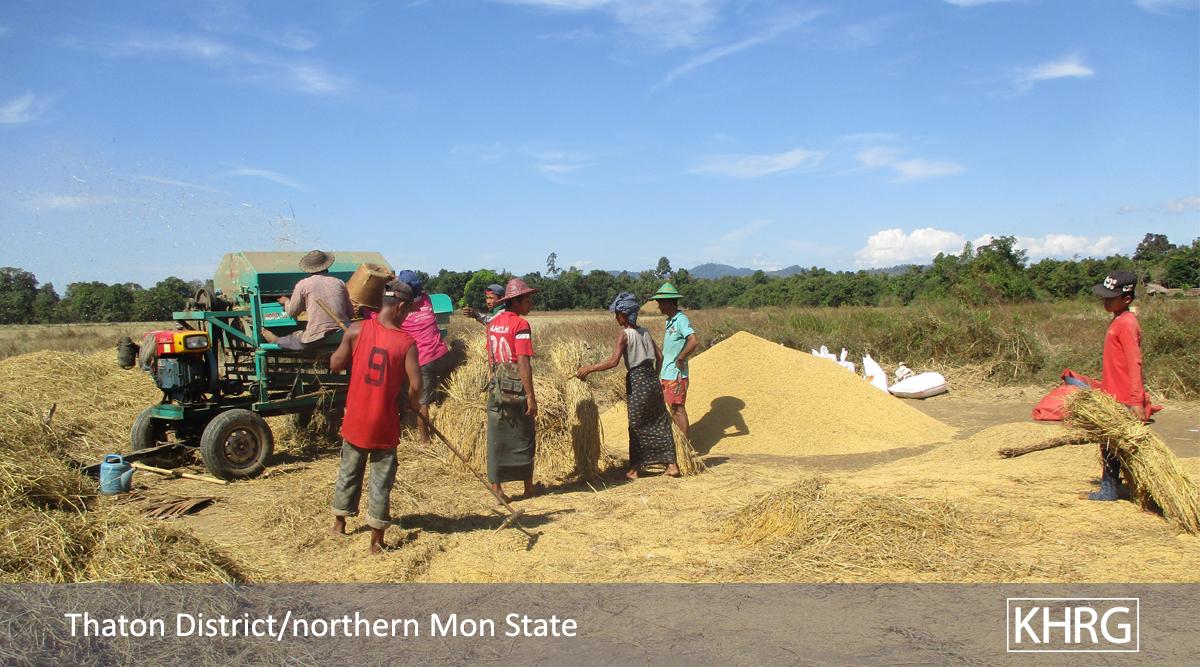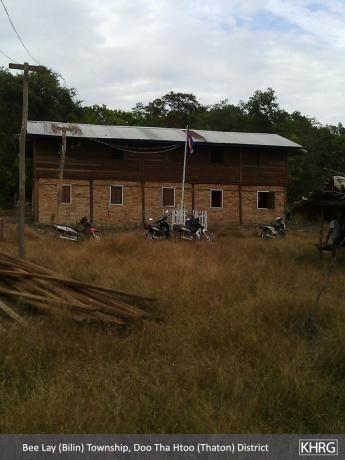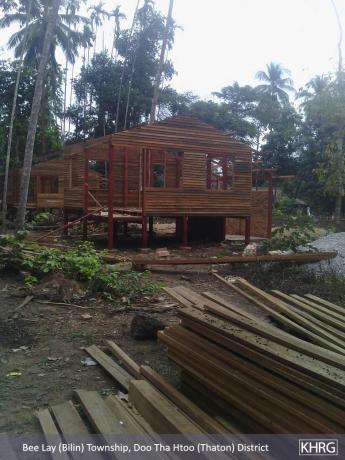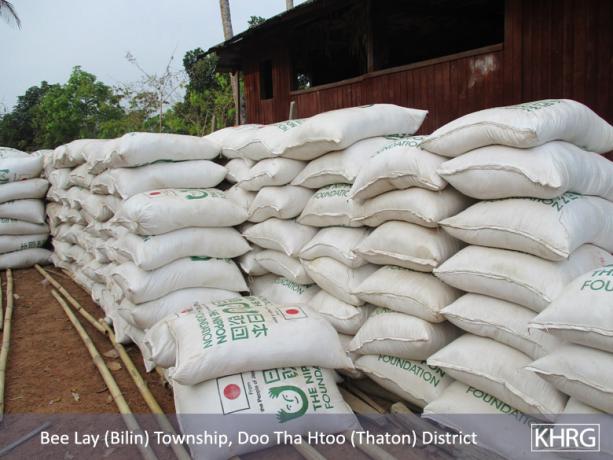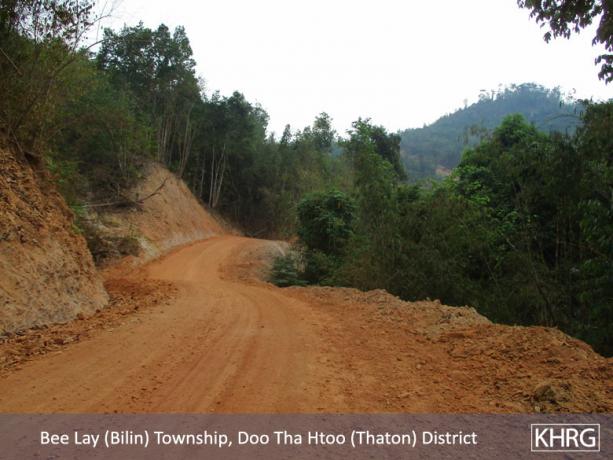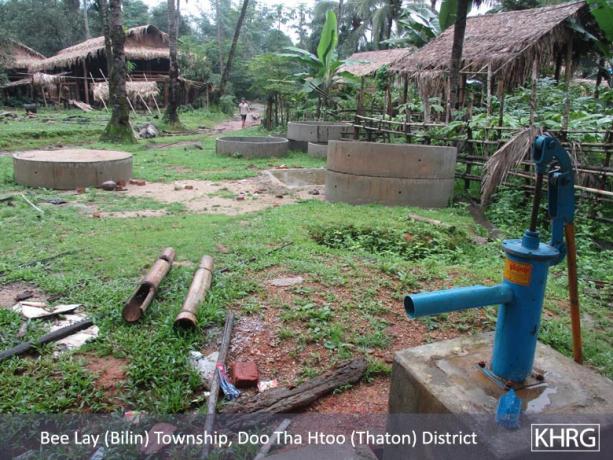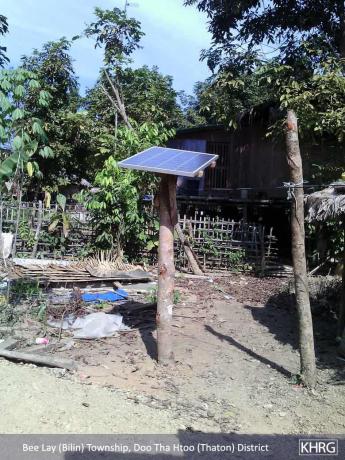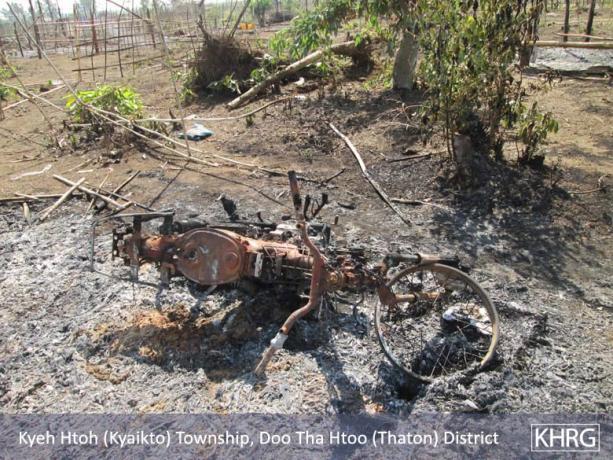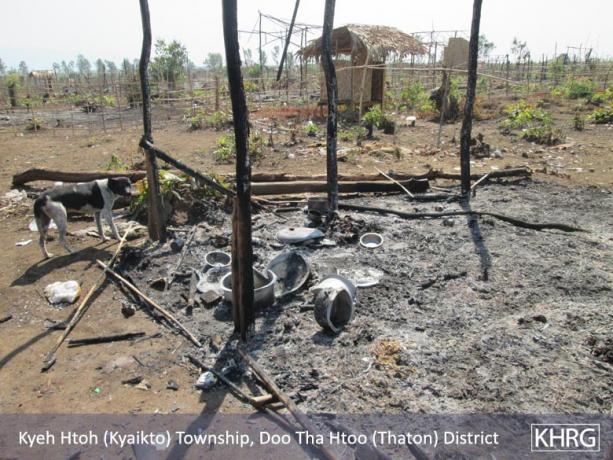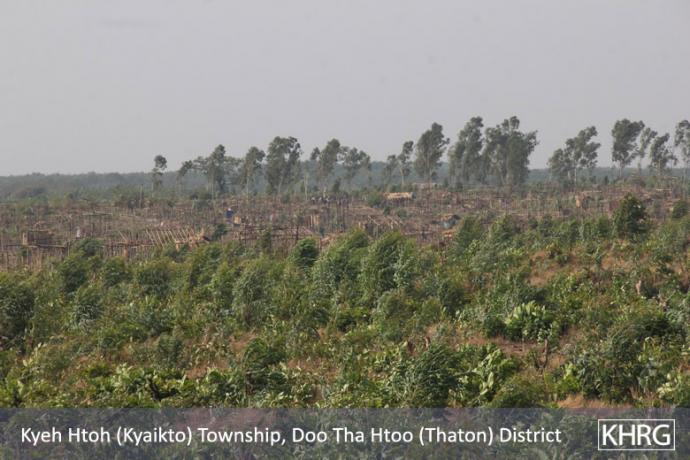Thaton Field Report: January 2016 to December 2017
This Field Report describes events occurring in Thaton District, southeast Myanmar between January 2016 and December 2017. It includes information submitted by KHRG community members on a range of human rights violations and other issues important to the local community including the military situation in the post-ceasefire period, development projects, drug usage, ethnic and religious discrimination, and violence because of conflicts about land use.
- According to the information received during KHRG’s 2 year reporting period, Tatmadaw military movement in Thaton District has been ongoing. Military movement includes Tatmadaw troops encamping in villages and being stationed more permanently in bases near villages.
- In this reporting period, many infrastructure projects were implemented across Thaton District. Nippon Foundation (locally known as Japan non-government organisation), Bridge Asia Japan (BAJ), Swiss Agency for Development and Cooperation (SDC), Community-Driven Development (CDD), Myanmar government and private companies developed infrastructure projects in Bilin Township such as building clinics, schools, roads and bridges in addition to improving water supply and distributing rice, and installing solar panels.
- Yaba (methamphetamine) is prevalent in many areas throughout Thaton District. Villagers have many concerns about this and worry about the future impacts of drug use, especially for their children and young people.
- Ethnic and religious discrimination remains of concern in Thaton District. Incidents include Muslim residents being denied their national identity cards, preventing them from enjoying full citizenship rights.
- Conflicts over land occurred in Thaton District due to arbitrary land grabs. A group of village leaders confiscated land that was used by landless people to resettle. As a result, total of 650 houses and huts were destroyed and burnt down by the local village authority in Kyaikhto Township, Thaton District in January and February 2016.
Preface
This field report is a summary of data received over a two year reporting period, highlighting the situation on the ground in Thaton District. Between January 2016 and December 2017, KHRG received 12 reports from field researchers in Thaton District. The data that was analysed for this field report includes one published and two unpublished interviews, two published and six unpublished situation updates and one published news bulletin. The limited number of reports received does not indicate that there has been a reduction in the frequency of human rights violations in Thaton District during 2016 and 2017.
Thaton district
The KNU-defined Thaton District (Doo Tha Htoo in Karen) is a mixed-control area split between KNU and Burma/Myanmar government, located in the northern Mon State bordering with Bago Division and Kayin State according to Burma/Myanmar government-defined territory. The townships in Thaton District are similarly defined under both Karen National Union (KNU) and Burma/Myanmar government administrations. In KNU-defined territory, there are five townships in Thaton District and in Burma/Myanmar government defined territory, there are four townships as Hpa-an Township is not included. Although all townships in Thaton District are KHRG research areas, KHRG researchers cannot access the entire area of each of the townships to document all human rights abuses especially Paung (Maws’ko) Township in the south of Thaton District which it is under mixed control between the Mon government (New Mon State Party) and Burma/Myanmar government. Thaton Town is defined under the KNU as the capital of Thaton District.
The post-ceasefire military situation
The military situation in Thaton District is not yet stable. Although there was a political transition through Nationwide Ceasefire Agreement (NCA)[1] to further the peace process, local civilians in Thaton District witnessed ongoing military activities by Tatmadaw, Border Guard Force[2] (BGF) and Karen National Liberation Army (KNLA). Rather than expecting a stable military situation and peace, villagers are concerned for their livelihoods and safety, and are worried that the fighting will restart. These observations are rooted in the facts and perspectives of the villagers reported below.
According to the information from the received reports, military activity in Thaton District is still ongoing in 2016 and 2017. In Bilin Township, villagers continue to see military groups of Tatmadaw and Border Guard Force (BGF) that are especially active in the area. Ongoing military activities such as encamping and patrolling by the Tatmadaw and BGF in Bilin Township caused many villagers to worry that the situation will transition into war instead of peace.
Villagers from Bilin Township reported that on February 23rd 2016, there was a lot of military patrolling by Tatmadaw and BGF. Some groups entered into the local area and encamped in the villages but some were already based in the villages. The groups that encamped in the villages were Ta Paw (Win Ta Pan) Army Camp, Lay Kay Army Camp, Yoh Klah Army Camp, Meh Pree Hkee Army Camp [and] the BGF from battalions #1014 and #1011. The groups that were already based in the villages and patrol village to village were Tatmadaw military from LID [Light Infantry Division] #44, LIB [Light Infantry Battalion] #118. Villagers from Htaw Klaw Hkee village (a village included in Tatmadaw patrols) thought that the Tatmadaw will relocate after the NCA was signed, but in the reality the soldiers remained in their village. Although the soldiers who are present in the village did not cause any trouble, villagers, especially women, are concerned for their daily safety. [3]
In a previously published KHRG situation update, a KHRG community member reported that
“In each army camp, two to three Tatmadaw soldiers stay with the BGF, but the Tatmadaw army column patrols around and stay in the villages. In 2016, we saw that they [Tatmadaw army] operated more and they were going around as they liked [without the permission of the KNU or villagers]. These Tatmadaw activities have been increasing and they have not been following the Nationwide Ceasefire Agreement,[4] so civilians are worried that the fighting will happen again”.
Situation update written by KHRG community member in Bilin Township, Thaton District (Published in April, 2017)[5]
The quote above clearly indicates that Tatmadaw does not follow the code of conduct of the Nationwide Ceasefire Agreement (NCA). The NCA code of conduct, Chapter 3[6], Section 7 (d) clearly states that the Tatmadaw and Ethnic Armed Organisations shall confine their troops within their designated area in order to avoid confrontation. Moreover, Section 8 (b) also states that the movement of armed troops in the area controlled by the other [party] is allowed only after obtaining prior agreement. In fact, Tatmadaw and the BGF broke the aforementioned terms of the NCA code of conduct not only in Thaton District but also in other KHRG documented districts where it led to outbreak of fighting[7].
Similarly, in a previously published KHRG situation update, villagers also reported that starting from April 23rd 2016 until December 31st 2016, Tatmadaw Light Infantry Division[8] (LID) #44 and the BGF gather and work together to patrol around many villages in Bilin Township.[9]
A villager from Kya Thaung Seik village tract expressed his perspective on the Tatmadaw activities that clashed with NCA commitments, such as cooperation with BGF when patrolling and replacement with BGF during the encamping process:
“After the Nationwide Ceasefire Agreement [NCA] was signed [between ethnic armed groups and the Burma/Myanmar government in 2015], these Tatmadaw camps were replaced by the Border Guard Force [BGF]. Nevertheless, the Kya Thaung Seik army camp in Kya Thaung Seik village tract remains situated on religious land [belonging to a monastery]. Before the NCA, Tatmadaw stole villagers’ belongings and arrested villagers, including women, to serve as porters and human shields on the front line. Drunk Tatmadaw soldiers have also stolen villagers’ belongings and animals. During the last two years, BGF soldiers have also stolen villagers’ vegetables and fruits.”
Situation update written by KHRG community member in Bilin Township, Thaton District (Published in February, 2018)[10]
In terms of the protection of civilians, the commitment outlined in the Chapter 3, Section 9 (d)[11] of the NCA clearly states that Tatmadaw and ethnic armed organisation have to avoid forcibly taking money, property, food, labor or services from civilians.
The outlined military activities, such as being present in villages, and patrolling village to village, have a strong impact on all of the village tracts of Bilin Township. At the same time, when Tatmadaw and BGF are cooperating by patrolling and encamping, it causes more concerns for the villagers because this mimics military activities that happened during the peace process period. In addition, breaking the code of conduct of the NCA is also a strong factor contributing to the fear of villagers. Villagers are worried about the peace process because their experience of the post-NCA period is the opposite that they thought it would be.
Karen National Liberation Army Recruitment
While villagers reported a lot on Tatmadaw and BGF activities, they also reported on the Karen National Liberation Army (KNLA). During the period of engagement with the peace process, it is crucial for all military actors to follow the code of conduct of the NCA for villagers to trust the peace process.
According to one of the published situation updates, there has been a strengthening [increased recruitment] of the KNLA in July 2017[12]. A KHRG community member reported that the recruitment was disappointing for the villagers. The NCA Chapter 3[13], Section 5 (c) states that the signing parties agreed to ‘avoid troop reinforcement in the ceasefire areas other than the provision of administrative support, emergency, medical support and routine rotation of troops’. By reflecting on the terms of the NCA, KHRG developed an understanding that there were failures of both parties to obey the commitment of the code of conduct. This caused a slowdown in the implementation of the peace process. The trust of local populations in the peace process has eroded since they saw that both parties did not follow the rules set in the NCA. Instead, the military activities continued as they used to before the signing of the NCA.
By analysing all of the information presented above, it becomes clear that the villagers in the Thaton District are experiencing the same trends of military actions that are felt across other districts where KHRG operates in southeast Myanmar. Most importantly, villagers are very concerned about the possible renewal of the fighting due to the increase of military movements such as patrolling and encamping in the local community since the signing of the NCA.
The ongoing nature of military activities on the ground has led to concerns over the restarting of armed conflict in Karen State and increasing doubts of the local population in the peace process. Despite the signing of NCA, political and strategic goals remain prevalent across all signatory parties.
Community Development Projects
The aim of this section is to highlight how community development projects often lack accountability and continuous social support. Since the previous government’s era, most notably, after the 2012 preliminary ceasefire[14], community development projects were widely implemented across the country. KHRG finds that the lack of accountability and community consensus for most projects is due to fact that most development implementers do not abide by the practices of Free, Prior and Informed Consent (FPIC).
KHRG analysed seven reports that cover information related to community development projects. Villagers have mixed perspectives on community development projects, based on the service that they receive and the type of project that is being conducted in their area. When reviewing the development projects that have had a negative impact on local communities, our evaluation emphasizes what kind of human rights violation have occurred and how villagers have responded to negative impacts of development projects.
During 2016 and 2017, the villagers from Thaton District, especially from Bilin and Hpa-an townships, reported that there were community development projects that were conducted by INGOs, NGOs, Myanmar government, local authorities and private companies. During 2016 and 2017, the type and the amount of community development projects did not change from the 2015 reporting period. Negligence related to community development also occurred at a similar level.
Nippon Foundation (locally known as Japan non-government organisation), Bridge Asia Japan (BAJ), Swiss Agency for Development and Cooperation (SDC), Community-Driven Development (CDD), Myanmar government and private companies implemented infrastructure development projects such as the construction of clinics, schools, roads, bridges, water supply, as well as the distribution of rice and solar panels.
One of the trends of community development projects in Karen State is that the project implementers are operating without accountability and without proper consultations with the local community. When activities are carried out without accountability for the destruction or negative impacts, it causes frustration for the villagers. The community perceives that this type of projects is not beneficial to them. This indicates that the development implementers did not take the necessary steps to align their work with the standard of Free, Prior and Informed Consent (FPIC). The lack of consultation and disregard for FPIC creates the risk that the services that are being provided do not meet local needs.
On May 2016, a KHRG community member reported on how the villagers perceived community development project - a clinic that has been constructed in their village:
“The clinic was already built and the opening ceremony also was already held but until the present time, the lock [on the clinic] has never opened. There are also no medics or patients. The villagers were mainly talking about this clinic. A villager from Eu--- village said that the clinic looks very beautiful but you cannot use it for anything. Villagers in Eu--- village also said that there is no [change], only the clinic has been built and nothing is inside. Therefore, they went to one old grandfather who does not have any relatives to live with, and they asked him to live in the clinic because the grandfather doesn’t have any house and he also cannot work”.
Situation update written by KHRG community member in Bilin Township
(Published in February 2018)[15]
Another situation update highlighted how a similar development project was conducted without the consent of local people:
“The villagers did not know anything regarding the wells that were dug in E--- village, Htee Maw Hkee village tract, Bilin Township. The diggers who came to dig the wells do everything as they want. They did not dig the wells in the place where the villagers want them to dig. They found the place where they want to dig the wells. Regarding to each development project activity, we have seen the workers and the KNU responsible people came to do it. They never informed or consulted with the villagers in anywhere”.
Situation update written by KHRG community member in Bilin Township, Thaton District
(received in August 2016)[16]
While some community development projects were negatively perceived by the local community, some villagers have exceptionally positive view regarding school construction and water supply as noted in a situation update from Bilin Township. Villagers were very happy when an organisation called Bridge Asia Japan (BAJ) constructed schools in many villages including a large village with a big student population. As the school was constructed with concrete, villagers were very satisfied. If they had to build a school of their own, they could only afford building a school with wood and bamboo. Moreover, that organisation also provided a water instalment in their village. The villagers perceived that it is as very useful because in the summer time the heat wave was very high and caused water streams and wells that are usually used by villagers to dry up.[17]
As highlighted in another situation update, villagers had both negative and positive views regarding road constructions that were implemented in Bilin and Hpa-an Townships in this reporting period. Villagers can now travel easily and freely due to the improvement of the transportation as the roads became more accessible. However, villagers were not compensated for the destruction of their plantations and paddy fields caused by the road constructions[18].
By analysing the villagers’ concerns of the negative and positive impact of the community development projects, KHRG clearly identifies the need for consent and community consultations before development projects take place. Infrastructure projects, such as the construction of clinics, need to ensure that the institution functions in a way that meets the needs of the local community. KHRG has received many reports from villagers who perceived that the implemented projects did not bring any benefit to their village or meet the community needs. In the case of road constructions, implementers should take accountability for any destruction of property and ensure that the local population is compensated for their losses. With increased accountability and consultations with local communities, development projects can ensure successful implementation.
Availability of Yaba drug (Methamphetamine) causes local concern
“There is an increasing number of drug users amongst villagers”
A villager from Bilin Township, Thaton District (Situation update published in February 2018)[19]
Yaba[20] is one of the best known drugs in Myanmar that causes civilians to be concerned about addiction in their daily lives and other negative consequences on society.[21] Especially in areas controlled by Karen ethnic armed groups’, yaba is one of the most serious issues that causes concern for the local community. In Thaton District and other districts where KHRG is operational, villagers had the same concerns relating to yaba. KHRG has previously published a number of reports[22] from other districts related to yaba.
According to a situation update previously published by KHRG [23], yaba was not well-known before the preliminary ceasefire in 2012. However, after that it became prevalent in every area of Bilin Township, Thaton District. Due to the improvements of the roads and transportation during the transition period, travelling by motorcycles and cars got easier without [police] checks. Therefore, yaba became easier to transport and now enters into the local communities quickly. In the past, villagers heard that yaba was traded by unofficial cow or buffalo traders, who were passing through to other areas, but now they see that it is sold by local people too.
Since yaba became easily accessible in the local communities, the user base has notably increased, as young people started using yaba. As noted by the KHRG community member:
“We have seen a lot of drugs coming to many villages in Bilin Township.[24] We also have seen that many young people have been secretly using drugs. If you need to buy or sell them you can find them very easily. Therefore, some villagers have many concerns and they worry that their children and youths will be impacted by drug use in the future”
Situation update written by KHRG Community member in Bilin Township
Thaton District (Published in February 2018)[25]
As yaba enters villages in many different ways and is easily accessible for users, it is very difficult to eliminate the drug from local communities. Villagers in all the districts where KHRG is operating have noted that yaba could not be eliminated by local authorities themselves, as the sellers and buyers included armed actors. Therefore, eradicating yaba is a sensitive issue to handle because the perpetrators who distributed yaba included authority holders.
One village tract leader reported:
“According to the drug research by the police [KNU], there are many drug users in the villages.” Another villager also reported that, “Many BGF soldiers in F--- village use yaba and distribute it to other places [villages].
Situation update written by KHRG community member in Bilin Township, Thaton Distirct
(Published in February 2018)[26]
Villages are concerned that the future generation will become victims of yaba addiction. Villagers in all seven districts where KHRG operates have reported that it is very difficult for the local authorities to eliminate this drug when yaba drug is traded by powerful armed groups. Because armed groups cannot be controlled by the government, it is hard to regulate and control yaba.
Discrimination
During the 2016 and 2017 reporting periods in Thaton District, KHRG analysed two interviews that covered the discrimination of Muslims. Among all of the ethnic minorities in Myanmar, Muslims[27] are one of the ethnic peoples who face a lot of discrimination by the Myanmar government and other ethnic groups. Muslim people face barriers to access citizenship when acquiring Identification Cards (ID). Being a civilian without a national ID card is very challenging in Myanmar. It create barriers to education, it makes it more difficult to get a job, and creates barriers to freedom of movement and travel. The discrimination against religion, race and colour is considered a serious human rights violation that is clearly stated in articles of Universal Declaration of Human Rights (UDHR),[28] one of the international conventions on human rights that the Myanmar government ratified in 1948.[29]
According to a Muslim villager from A--- village, P’Newh Klah village tract, Thaton Township, Thaton District who was interviewed by a KHRG community member in April 2016:
“Since we do not have Identification card, we face difficulties; we cannot travel to where we want.” Identification card is not taken for ka la[30] [Muslim].”
He also continued to express his feelings on this discrimination:
“I do not feel good. Not only me but also my children have difficult [to travel if we do not have identification card]. There is no problem for me [although I do not have identification card] as I am getting old but I am worried for my children for their future. It will be difficult for them to travel from place to place if they do not have Myanmar identification card. For example, even though a student passes tenth standards, she/he cannot get a job if she/he does not have identification card [31].”
Interview by KHRG community member, Thaton Township, Thaton District
(Received in May 2016)[32]
Another Muslim villager from P’Newh Klah village tract, Thaton Township, Thaton District who was interviewed by a KHRG community member also explained the barriers to getting an ID card for Muslims:
“I already talked to the village administrator but it did not work. They said we have to apply to the District office if we want ID card. How can we apply for an ID card from the District office if we do not have money? Some Muslims have applied for an ID card from the District office but most of them did not get one. They faced many problems when they applied such as [requests for their] family household and ancestor record issues. So they just lost their money and came back home without getting an ID card.”
He also discussed his experience when he tried to get an ID for his daughters who are students:
“I tried to talk to U T--- [former village head] to make my daughters get ID cards because they need ID cards when they go to study at the college. He rejected my words. All my words were useless. Now the Myanmar government came to make ID card for the students at the school but our Muslim children were rejected because they [the government] said we have to go and ask for ID cards at the Township level if we want to make one. It is not easy to make an ID card if we go to the Township office. Also, we have to pay a lot of money. Some Muslim people reported the case many times but in the end, they just lost their money.”
The refusal to issue a national ID card due to ethnicity and religion is a form of discrimination that leads to other violations of human rights, because it limits the possibility for this individual to access education, secure a livelihood, and move freely. According to the UDHR, everyone should benefit from these rights equally. The interviews received by KHRG prove that this is not the case for Muslims in Myanmar.
Additionally, the Muslim villager that was interviewed by KHRG gave us his general perspective on Muslims in the community, stating that “the people from the upper land, C--- village, B--- village, and D--- village have never seen us in a negative way until now, but for the people who are from the other side [a different area] [they have a negative view] and I know about U Maung Gyi [a man from the different area who has a bad attitude towards Muslims]; they dislike Ka la. They never want to see us. We have been suffering brutally. We have a lot of examples to express our sufferings.”
U A---, (male, 58), B--- village, Thaton Township, Thaton District,
(Interviewed in April 2016)[33]
These examples of discriminations against ethnic minorities are indicative of human rights violations not only in KHRG operation areas, but also throughout Myanmar. There are many other examples of discrimination that KHRG has previously reported on, including limits to the freedom of religion[34], barriers to accessing healthcare[35] and education[36] and instances where minority rights were curtailed[37] An overall overview of discrimination that Karen and Muslim minorities face in Karen state can be found in chapter 8 of Foundation of Fear the thematic report published by KHRG.
KHRG found that discrimination is evident not only in instances of human rights violations, but also when minorities have sought to access justice following a human rights abuse. Moreover, there are many examples of discrimination in other parts of Myanmar covered by external media sources; such as the discrimination and ethnic cleansing of the Rohingya minority[38]. Human rights officials have denounced the ‘brutal operation against Muslim minority in Rakhine State[39], and Myanmar’s discrimination against the Rohingya population.[40]
The examples of human rights violations against Muslims highlighted in this section show how the human rights situation in Thaton District is still weak. It reflects a broader nationwide problem of discrimination against religious and ethnic minorities.
Violence because of conflicts about land use
Since its establishment, KHRG has received reports of land confiscations in every district that it operates in. During the transition period when the peace process was initiated, land issues became prevalent following a rise in commercial development. Land issues are common across development sectors and are perpetrated by various powerful actors such as government and local authorities, armed groups, companies and wealthy individuals. This includes examples of leasing and investing in land for private profit, implementing infrastructure development projects infrastructure, mining to extract natural resources, and acquiring land for military purposes. Land issues have wide-ranging consequences, including livelihood problems, displacement and social conflict. More reports on land issues can be found in online publication on KHRG website and in print.
During the 2016 and 2017 reporting period, KHRG published a news bulletin highlighting social conflicts that were related to land issues in Thaton District. Individual actors cooperated with the local authorities, asking people to invest in land in Wad Da Kwin village in order to gain personal profit. People used to live in Wa Da Kwin village during the conflict period. However, the frequent fighting between Tatmadaw and ethnic armed groups forced the villagers who lived in Wa Da Kwin to leave in order to flee the fighting. During the peace process, Wa Da Kwin became vacant land[41]. In this context, landless people resettled in Wa Da Kwin. On the other hand, the landless people who came and resettled in the Wa Da Kwin area were reportedly grabbing land on their own merit. These are the root causes of the land conflict discussed below.
A group of people (Wa Da Kwin villagers) with one full truck and 13 motorbikes all wearing military uniform attacked another group of villagers on January 29th and February1st 2016. Before this incident happened, the villagers who got attacked reported to KHRG community member that Pe Thi, a hundred household leader[42] of Wa Da Kwin village, and his associate, Nga Myo, met with people in H--- village and persuaded villagers to go and have a look at A--- place and asked if they wanted to invest in A--- place. Although annual profits from the investment were promised, most of the villagers present were poor fishermen who could not afford the amount required to make an investment.
However, in early January 2016, they [villagers who were displaced] heard that the plots that Nga Myo showed to the H---villagers earlier were now available for free. Consequently, many villagers [including villagers who were displaced] went to the monastery near A--- and started measuring and drawing up plots on the land. Since then, villagers from different places who do not have land went and settled in A---place which is an expanding area of Wa Da Kwin. As a consequence, a group led by Pe Thi who is a hundred household leader of Wa Da Kwin attacked the villagers who built houses in A--- place, an area which Wa Da Kwin village is expanding into. The group, which was armed with knives, iron rods, slingshots, and bamboo sticks, destroyed houses and set them ablaze, and also attacked the people staying there. According to witnesses at the scene, one woman died and several people were injured during the attack, and most of the villagers’ belongings were destroyed in fire. As the result of the attack, a total of 650 houses and huts were destroyed and burnt down by the local village authority in Kyaikhto Township, Thaton District in January and February 2016[43].
There are a lot of examples of land becoming vacant in southeast Myanmar that have become vacant because villagers had to leave their land in order to flee the fighting. However, after the preliminary ceasefire in 2012, these vacant lands have been confiscated by various actors for many purposes. According to the Myanmar farmland law[44] on Vacant and Fallow land of 2012, this type of confiscations is allowed.
Conclusion
This Field Report covered information from 12 raw data reports received during 2016 and 2017 reporting period. It summarised the situation in Thaton District by analysing the impact of military presence and development projects on villagers. It also highlighted the increasing problem of drugs in the community, instances of discrimination against Muslims, and a land conflict that occurred in Wa Da Kwin village. .
Because of ongoing military movements by armed groups that signed the NCA, villagers in Thaton District are very concerned that the ceasefire agreement will be broken and the fighting will restart. Development projects are often implemented with inadequate consultations with the local community and a lack of accountability. Because of the low standards of FPIC compliance, villagers were denied their rights to be properly informed about development projects, to voice their concerns, and to be fairly compensated for the negative impacts of development projects.
Another key complaint is the prevalence of yaba in the Thaton District, which is not only increasingly available, but often distributed by powerful actors such as armed groups.
The Muslim minority in Thaton District continued to face discrimination by the government due to their ethnicity and religion. Often, Muslims are denied national ID cards, which limits their ability to access education, move freely and get a job.
During 2016 and 2017, the overall situation in Thaton District did not improve despite the ongoing peace process. This report highlights that there are many cases where justice, human rights, and accountability are not sufficiently respected. Villagers in Thaton District have experienced many negative outcomes of the process of political transition, and are worried that peace will not last in their area.
Footnotes:
[1] On October 15th 2015, after a negotiation process marred with controversy over the notable non-inclusion of several ethnic armed groups and on-going conflicts in ethnic regions, a Nationwide Ceasefire Agreement (NCA) was signed between the Burma/Myanmar government and eight of the fifteen ethnic armed groups originally invited to the negotiation table, including the KNU, see “Myanmar signs ceasefire with eight armed groups,” Reuters, October 15th 2015. The signing of the NCA followed the January 12th 2012 preliminary ceasefire agreement between the KNU and Burma/Myanmar government in Hpa-an. Karen civilians and the KNU have more recently expressed their concerns about the lack of progress in moving from a ceasefire towards genuine political dialogue. See, KNU Chair Highlights Weaknesses In The NCA During Anniversary Celebrations, Karen News, October 2017 and NCA signatories urge govt to reboot peace process, DVB, October 2017.
[2] Border Guard Force (BGF) battalions of the Tatmadaw were established in 2010, and they are composed mostly of soldiers from former non-state armed groups, such as older constellations of the DKBA, which have formalised ceasefire agreements with the Burma/Myanmar government and agreed to transform into battalions within the Tatmadaw. BGF battalions are assigned four digit battalion numbers, whereas regular Tatmadaw infantry battalions are assigned two digit battalion numbers and light infantry battalions are identified by two or three-digit battalion numbers. For more information, see “DKBA officially becomes Border Guard Force” Democratic Voice of Burma, August 2010, and “Exploitation and recruitment under the DKBA in Pa’an District,” KHRG, June 2009.
[3] This information is taken from “Thaton Situation Update: Bilin Township, February to April 2016,” KHRG, February 2018.
[4] On October 15th 2015, after a negotiation process marred with controversy over the notable non-inclusion of several ethnic armed groups and on-going conflicts in ethnic regions, a Nationwide Ceasefire Agreement (NCA) was signed between the Burma/Myanmar government and eight of the fifteen ethnic armed groups originally invited to the negotiation table, including the KNU, see “Myanmar signs ceasefire with eight armed groups,” Reuters, October 15th 2015. Despite the signing of the NCA prompting a positive response from the international community, see “Myanmar: UN chief welcomes ‘milestone’ signing of ceasefire agreement,” UN News Centre, October 15th 2015, KNU Chairman General Saw Mutu Say Poe’s decision to sign has been met with strong opposition from other members of the Karen armed resistance and civil society groups alike, who believe the decision to be undemocratic and the NCA itself to be a superficial agreement that risks undermining a genuine peace process, see “Without Real Political Roadmap, Nationwide Ceasefire Agreement Leads Nowhere...,” Karen News, September 1st 2015. The signing of the NCA followed the January 12th 2012 preliminary ceasefire agreement between the KNU and Burma/Myanmar government in Hpa-an. For KHRG's analysis of changes in human rights conditions since the preliminary ceasefire, see Truce or Transition? Trends in human rights abuse and local response since the 2012 ceasefire, KHRG, May 2014.
[5] This information is taken from “http://khrg.org/2017/04/16-101-s1/thaton-situation-update-bilin-township-july-september-2016” KHRG, April 2017.
[6] “THE NATIONWIDE CEASEFIRE AGREEMENT BETWEEN THE GOVERNMENT OF THE REPUBLIC OF THE UNION OF MYANMAR AND THE ETHNIC ARMED ORGANIZATIONS”, (October 15th 2015), access date February 26, 2018.
[7] For more information about ongoing fighting in other districts of KHRG documentation area after NCA see “Ongoing fighting, displacement, landmines, porter demands, and child recruitment in Hlaingbwe Township, Hpa-an District, October and November 2017”, KHRG, December 2017 and “Dooplaya Situation Update: Kawkareik Township, June 2015 to August 2016”, KHRG, December 2016.
[8] Light Infantry Division (LID) of the Tatmadaw is commanded by a brigadier general, and consists of ten light infantry battalions specially trained in counter-insurgency, jungle warfare, search and destroy operations against ethnic insurgents . They were first incorporated into the Tatmadaw in 1966. LIDs are organised under three Tactical Operations Commands, commanded by a colonel, three battalions each and one reserve, one field artillery battalion, one armoured squadron and other support units. Each division is directly under the command of the Chief of Staff (Army).
[9] This information is taken from “Thaton Situation Update: Bilin Township, November 2016 to January 2017,”KHRG, February 2018.
[10] This information is taken from “Thaton Situation Update: Bilin Township, July to October 2017”, KHRG, February 2018.
[11] THE NATIONWIDE CEASEFIRE AGREEMENT BETWEEN THE GOVERNMENT OF THE REPUBLIC OF THE UNION OF MYANMAR AND THE ETHNIC ARMED ORGANIZATIONS, last access date February 26, 2018.
[12] This information is taken from “Thaton Situation Update: Bilin Township, July to October 2017”,KHRG, February 2018.
[13] “THE NATIONWIDE CEASEFIRE AGREEMENT BETWEEN THE GOVERNMENT OF THE REPUBLIC OF THE UNION OF MYANMAR AND THE ETHNIC ARMED ORGANISATION”, (October 15th 2015), access date February 26, 2018.
[14] On January 12th 2012, a preliminary ceasefire agreement was signed between the KNU and Burma/Myanmar government in Hpa-an. Negotiations for a longer-term peace plan are still under way. For updates on the peace process, see the KNU Stakeholder webpage on the Myanmar Peace Monitor website.
[15] This information is taken from “Thaton Situation Update: Bilin Township, February to April 2016”, KHRG, February 2018.
[16] This information is taken from unpublished situation update from Bilin Township received in August 2016.
[17] This information is taken from “Thaton Situation Update: Bilin Township, February to April 2016”, KHRG, February 2018.
[18] This information is taken from unpublished situation update received from Hpa-an township in June 2016. 16-49-S1
[19] This information is taken from “Thaton Situation Update: Bilin Township, July to October 2017”, KHRG, February 2018.
[20] Yaba, which means “crazy medicine” in Thai, is a tablet form of methamphetamine. First developed in East Asia during World War II to enhance soldiers' performance, methamphetamine has become increasingly popular in Thailand, Laos, Cambodia Vietnam, and in Burma/Myanmar where it is typically manufactured. See, "Yaba, the 'crazy medicine of East Asia," UNODC, May 2008 and “Woman raped and killed in Pa’an District, October 2012,” KHRG, December 2012, and “Chapter: Drug production, use and the social impacts in Southeast Myanmar since the January 2012 ceasefire,” KHRG, June 2014.
[21] Crime such as rape and killing happened implicated to yaba drug. See: “Dooplaya Incident Report: Rape and Killing of a teenage girl in Kawkareik Township, August 23rd 2016”, KHRG, January 2017.
[22] For more information related to yaba see, “Growing drug use and its consequences in Dooplaya and Hpa-an districts, between February and December 2015”, KHRG, May 2016 and “Hpapun Situation Update: Bu Tho Township, September to November 2016”, KHRG, June 2017.
[23] This information is taken from “Thaton Situation Update: Bilin Township, July to September 2016”, KHRG, April 2017.
[24] KHRG continues to receive reports detailing villagers’ concerns over increased drug use and drug trading in their communities. See for example “Growing drug use and its consequences in Dooplaya and Hpa-an Districts, between February and December 2015,” May 2016.
[25] This information is taken from “Thaton Situation Update: Bilin Township, February to April 2016”, KHRG, February 2018.
[26] This information is taken from “Thaton Situation Update: Bilin Township, July to October 2017”, KHRG, February 2018.
[27] The classification ‘Muslim’ in Southeast Myanmar is referred to and often self-identified as both a religion and an ethnicity. Muslims in Myanmar can be of different or mixed ethnicity. In Rakhine State there are two main groups, the self-identified Rohingya Muslims (not recognised by the Myanmar government and referred to as Bengali) and the Kaman/Kamein Muslims (officially recognised as one of Myanmar's 135 ethnic races). Outside Rakhine State, Muslims can also be Indian Muslims, Pakistani Muslims, Malay Muslims, Chinese Muslims (Panthays), Burmese converts, and Muslims from mixed marriages. Throughout KHRG's 25-year reporting history Muslims in southeast Myanmar have not identified themselves as Rohingya and mostly self-identify as 'Muslim'. For more information regarding Muslims in Myanmar see: The Muslims of Burma: A study of a minority Group, YEGAR, M.,1972; Between Integration and Secession: The Muslim Communities of the Southern Philippines, Southern Thailand, and Western Burma/Myanmar, Wiesbaden: O. Harrassowitz; YEGAR, M. (2002); PRIESTLEY, H. (2006) ‘The Outsiders’, The Irrawaddy, [Online] January; MATTHEWS, B. (2001) ‘Ethnic and Religious Diversity: Myanmar’sUnfolding Nemesis’, Institute of South East Asian Studies, [Online] Visiting Researchers Series 3.
[28] Article 2: Everyone is entitled to all the rights and freedoms set forth in this Declaration, without distinction of any kind, such as race, colour, sex, language, religion, political or other opinion, national or social origin, property, birth or other status. Furthermore, no distinction shall be made on the basis of the political, jurisdictional or international status of the country or territory to which a person belongs, whether it be independent, trust, non-self-governing or under any other limitation of sovereignty: Article 15 “Everyone has the right to a nationality”, ‘Universal Declaration of Human Rights’ United Nations General Assembly, 1948.
[29] See: “THE GLOBAL NEW LIGHT MYANMAR,” Dr.Khine Khine Win, Director of Myanmar National Human Rights Commission, May 2016.
[30] Ka la, is a Burmese/Myanmar term which is sometimes used to refer to individuals in Burma/Myanmar who are perceived to have a darker skin colour. In Kayin state, it is often associated specifically with followers of Islam (Muslims), although this association is sometimes erroneous, and Muslim individuals do not typically self-identify with this term.
[31] In UDHR article 15; (1) everyone has the right to a nationality and in article 13: (1) everyone has the right to freedom of movement and residence within the borders of each state, ‘Universal Declaration of Human Rights’ United Nations General Assembly, 1948.
[32] This information is taken from unpublished interview received from Thaton Township, Thaton District in May 2016.
[33] This information is taken from “Thaton Interview: U A---, 2016”, KHRG, December 2016.
[34] For detail information see; “Toungoo Interview: Maung A---, April 2015,” KHRG, January 2016.
[35] For detail information see, “Toungoo Situation Update: Thandaunggyi Township, June to August 2016”, KHRG, March 2017.
[36] This information is taken from “Thaton Interview: U A---, 2016”, KHRG, December 2016.
[37] See, “Thaton Situation Update: Thaton Township, January to June 2015,” KHRG, January 2016.
[38] See; “Discrimination; The Rohingya minority”, AMNESTLY INTIONATIONAL, last access February 9, 2018.
[39] See, “Myanmar treatment of Rohingya looks like 'textbook ethnic cleansing', says UN”, The Guardian, September 2017.
[40] See, “Myanmar's discrimination against Rohingya Muslims is 'apartheid': Amnesty International”, ABC News, November 2017.
[41] According to vacant, fallow and virgin land management law, vacant land and fallow land mean the land on which agriculture or livestock breeding business can be carried out and which was tenanted in the past and abandoned for various reasons and without any tenant cultivating on it and the land which are specifically reserved by the state. For more detail about Myanmar land law see: https://www.lift-fund.org/sites/lift-fund.org/files/uploads/Vacant,%20Fallow%20.....%20Land%20Law.pdf.
[42] In larger villages located near towns in Burma/Myanmar, one leader is elected per one hundred households to take responsibility for them.
[43] For detail information see: “Trespassing villagers’ houses destroyed and burnt down in Kyaikto Township, Thaton District, February 2016”, KHRG, July 2016.
[44] The Farmland Law of 2012, which covers the confiscation process for land actively being used; and the Vacant, Fallow, and Virgin Land Law, which allows for the confiscation of any land categorized as vacant, fallow, or virgin. Although villagers never explicitly name these laws, a number of cases were reported in which government officials or wealthy actors demarcated land, both privately and communally held, as uncultivated in the process of confiscating it.
[45] These photos are taken from previous published KHRG news bulletin, “Trespassing villagers’ houses destroyed and burnt down in Kyaikto Township, Thaton District, February 2016”, KHRG, July 2016.

